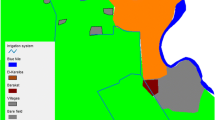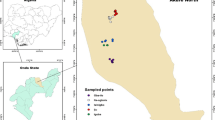Abstract
The structure of mosquito larvae breeding habitats were studied at Onicha Igbeze and its environ in Onicha Local Government Area of Ebonyi State, Nigeria. The study was carried out by identifying the larvae habitat, the structure, quality, measuring the temperature, pH and counting the number of larvae per breeding habitats. Larvae breeding habitats of different structures and quality were identified at twenty locations within the study area. The temperature of the breeding habitats ranged from 27.10ºC to 31.90ºC. Highest mean pH (8.50) was recorded at the breeding sites located at Isu Road 6. The anopheline mosquitoes were predominant among the two larvae types identified with the highest number (213 individual larva) recorded at Isu Road 2. Simple linear model performed depicted that larvae density increased with the habitats temperature and decreased with pH. Meanwhile, the study showed that the presence of larvae breeding habitats and an increase in environmental temperature favoured the breeding of mosquito larvae and could be setbacks to the fight against malaria.

Similar content being viewed by others
References
Amadi EC (2016) A review on malaria eradication: what hope for Nigeria? J Appl Sci Environ Manag 20(3):781–787
Ani OC, Ani EG, Odii BO, Okafor FC (2015) Malaria Parasitaemia among Residents of Isu Community, Onicha Local Government Area of Ebonyi State. Int J Sci Res 4(11):263–266
Arora DR, Arora B (2009) Medical parasitology, 2nd edn. CBS Publishers and Distributors Pvt Ltd., New Delhi, pp 67–81
Barros FSM, Arruda ME, Gurge HC, Honorio NA (2011) Spatial clustering and longitudinal variation of Anopheles darling (Diptera: Culicidae) larvae in a river of the Amazon: The importance of the forest fringe and obstructions to flow in frontier malaria. Bull Entomol Res 101(6):643–658
Carson R (1962) Silent spring. Houghton Mifflin, Boston, p 22
Choumet V (2012) Proteonomics of Anopheles gambiae. Malar Parasit 1:39–56
Christiansen-Jucht C, Parham PE, Saddler A, Koella JC, Basáñez MG (2014) Temperature during larval development and adult maintenance influences the survival of Anopheles gambiae s.s.. Parasit Vectors 7:489–499
de Souza D, Kelly-Hope L, Lawson B, WilsonM, Boakye D (2010) Environmental Factors Associated with the Distribution of Anopheles gambiae s.s in Ghana: an Important vector of lymphatic filariasis and malaria. PLoS One, 5(3): e9927. https://doi.org/10.1371/journal.pone.0009927
Dida GO, Anyona DN, Abuom PO, Akoko D, Adoka SO, Matano A, Owuor PO, Ouma C (2018) Spatial distribution and habitat characterization of mosquito species duringthe dry season along the Mara River and its tributaries, in Kenya and Tanzania. Infect Dis Poverty 7:2–18
Eckhoff PA (2011) A malaria transmission – directed model of mosquito life cycle and ecology. Malar J 10:303–310
Emidi B, Kisinza WN, Mmbando BP, Robert M, Mosha FW (2017) Effect of physicochemical parameters on Anopheles and Culex mosquito larvae abundance in different breeding sites in a rural setting of Muheza, Tanzania. Parasit Vect 10:304–315
Gillies MT, Coetzee MA (1987) Supplement to the Anophelinae of Africa South of the Sahara, Johannesburg. Publ South African Inst Med Res 55:1–143
Hopkins GHE (1952) Mosquitoes of the ethiopian region I.—Larval bionomics of mosquitoes and taxonomy of culicine larvae. Second Edition. (British Museum, Natural History, London, p 362
Killeen GF, Fillinger U, Kiche I, Gouagna LC, Knols BG (2002) Eradication of Anopheles gambiae from Brazil: Lessons for malaria control in Africa. Lancet Infect Dis 2(10):618–627
Kwasi B, Biology A, Kumasi T (2012) Physico-chemical assessment of mosquito breeding sites from selected mining communities at the Obuasi municipality in Ghana. J Environ Earth Sci 2:123–130
Lyimo EL, Takken T, Koella J (1992) Effect of rearing temperature and larval density on larval survival, age at pupation and adult size of Anopheles gambiae. Entomol Exp Appl 63:265–271
Mwangangia JM, Mbogo CM, Muturi EJ, Nzovu JG, Githureb JI, Noboru GY, Novak MR, John C (2007) Spatial distribution and habitat characterisation of Anopheles larvae along the Kenyan coast of Beiere. J Vector Borne Dis 44:44–51
Merritt RW, Dadd RH, Walker ED (1992) Feeding behaviour, natural food and nutritional relationships of larval mosquitoes. Annu Rev Entomol 37:349–376
Odikamnoro OO, Ikeh IM, Uhuo CA, Okoh FA, Ebiriekwe SC, Nnadozie IA (2016) Prevalence and management practices of malaria in a rural community of Ebonyi state, southeast Nigeria. IOSR J Pharm Bio Sci 11(1):61–65
Ogbuene EB (2010) Impact of meteorological parameters on rice yield: An approach for environmental resource sustainability in Ebonyi rice farmland. Journal of environmental issues and agriculture in developing countries 2(2–3):103–116
Okwa OO, Carter V, Hurd H (2007) Abundance, Host preference and Infectivity rates of malaria vectors in Badagry Local Government Area of Lagos Nigeria. Niger J Parasitol 27(1):41–48
Oyewole OI, Momoh OO, Anyasor GN, Ogunnowo AA, Ibidapo CA, Oduola OA, Obansa JB, Awolola TS (2009) Physicochemical characteristics of Anopheles breeding sites: Impact on fecundity and progeny development. Afric J Environm Sci Technol 3(12):447–452
Tadesse D, Mekonnen Y, Tsehaye A (2011) Characterization of Mosquito breeding sites in and in the vicinity of Tigray microdams. Ethiop J Health Sci 21(1):57–66
Tirado DF, Almanza-Vasquez E, Almanza-Meza EJ, Acevedo-Correa D, González-Morelo KJ (2017) Larval Development of Mosquitoes and pH of Different Reservoirs in the City of Cartagena de Indias (Colombia). Int J Eng Technol 6(9):4137–4140
Ukubuiwe AC, Ojianwuna CC, Olayemi IK, Arimoro FO, Ukubuiwe CC (2020) Quantifying the roles of water pH and hardness levels in development and biological fitness indices of Culex quinquefasciatus Say (Diptera: Culicidae). J Basic Appl Zool 81:5–15
Walker K, Lynch M (2007) Contributions of Anopheles larval control to malaria suppression in tropical Africa: Review of achievements and potential. Med Vet Entomol 21(1):12–21
World Health Organization (WHO) (2011) World Malaria Report, 2011. Geneva. http://www.who.int/malaria/world_malaria_report_2011/en/index.html (Accessed July 10, 2018)
World Health Organization (WHO) (2012) World Malaria Report 2012. WHO Press, Geneva, p 4
World Health Organization (WHO) (2013) Test procedures for insecticide resistance monitoring in malaria vectors. World Health Organization, Geneva, Switzerland, p 30
Yayock HC, Ndams IS, Kogi E, Ahmed AB, Vagime CG (2014) Distribution of mosquito species in Kaduna metropolis, Kaduna State, Northern Nigeria. Niger J Entomol 31:1–6
Acknowledgements
The authors wish to acknowledge posthumously, Nwafor Joseph Christain who assisted in the data collection during the study.
Funding
No funding was received from individual of organisation for the study.
Author information
Authors and Affiliations
Contributions
The first author designed the study, supervised data collection, anaylzed the data and drafted the manuscript while the second author collected the data, organized it, read the manuscript and made contribution before submission.
Corresponding author
Ethics declarations
Conflict of interest
The authors have no conflict of interest to declare.
Rights and permissions
About this article
Cite this article
Nwonumara, G.N., Nwele, D.E. Mosquito larvae breeding habitat as hitch to the fight against malaria in Onicha Igbeze and its Environ, Ebonyi State, Nigeria. Int J Trop Insect Sci 41, 2489–2499 (2021). https://doi.org/10.1007/s42690-021-00428-4
Received:
Accepted:
Published:
Issue Date:
DOI: https://doi.org/10.1007/s42690-021-00428-4




